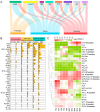Gene Regulatory Network Controlling Flower Development in Spinach (Spinacia oleracea L.)
- PMID: 38892313
- PMCID: PMC11173220
- DOI: 10.3390/ijms25116127
Gene Regulatory Network Controlling Flower Development in Spinach (Spinacia oleracea L.)
Abstract
Spinach (Spinacia oleracea L.) is a dioecious, diploid, wind-pollinated crop cultivated worldwide. Sex determination plays an important role in spinach breeding. Hence, this study aimed to understand the differences in sexual differentiation and floral organ development of dioecious flowers, as well as the differences in the regulatory mechanisms of floral organ development of dioecious and monoecious flowers. We compared transcriptional-level differences between different genders and identified differentially expressed genes (DEGs) related to spinach floral development, as well as sex-biased genes to investigate the flower development mechanisms in spinach. In this study, 9189 DEGs were identified among the different genders. DEG analysis showed the participation of four main transcription factor families, MIKC_MADS, MYB, NAC, and bHLH, in spinach flower development. In our key findings, abscisic acid (ABA) and gibberellic acid (GA) signal transduction pathways play major roles in male flower development, while auxin regulates both male and female flower development. By constructing a gene regulatory network (GRN) for floral organ development, core transcription factors (TFs) controlling organ initiation and growth were discovered. This analysis of the development of female, male, and monoecious flowers in spinach provides new insights into the molecular mechanisms of floral organ development and sexual differentiation in dioecious and monoecious plants in spinach.
Keywords: Spinacia oleracea L.; dioecious; floral development; monoecious; transcriptomics.
Conflict of interest statement
The authors declare no conflicts of interest.
Figures








Similar articles
-
Comparative Transcriptome Analysis of Gene Expression Between Female and Monoecious Spinacia oleracea L.Genes (Basel). 2024 Dec 27;16(1):24. doi: 10.3390/genes16010024. Genes (Basel). 2024. PMID: 39858571 Free PMC article.
-
Genome-wide analysis of MADS-box genes and their expression patterns in unisexual flower development in dioecious spinach.Sci Rep. 2024 Aug 11;14(1):18635. doi: 10.1038/s41598-024-68965-9. Sci Rep. 2024. PMID: 39128921 Free PMC article.
-
Gibberellins regulate masculinization through the SpGAI-SpSTM module in dioecious spinach.Plant J. 2024 Jun;118(6):1907-1921. doi: 10.1111/tpj.16717. Epub 2024 Mar 16. Plant J. 2024. PMID: 38491869
-
Tinkering with transcription factor networks for developmental robustness of Ranunculales flowers.Ann Bot. 2016 Apr;117(5):845-58. doi: 10.1093/aob/mcw037. Epub 2016 Apr 18. Ann Bot. 2016. PMID: 27091506 Free PMC article. Review.
-
The Quest for Molecular Regulation Underlying Unisexual Flower Development.Front Plant Sci. 2016 Feb 19;7:160. doi: 10.3389/fpls.2016.00160. eCollection 2016. Front Plant Sci. 2016. PMID: 26925078 Free PMC article. Review.
Cited by
-
Genome-wide identification of bHLH transcription factors related to plant development and abiotic stress response in sand rice (Agriophyllum squarrosum (L.) Moq.)).Genetica. 2025 Jun 4;153(1):21. doi: 10.1007/s10709-025-00238-3. Genetica. 2025. PMID: 40465032
References
-
- Renner S.S., Ricklefs R.E. Dioecy and its correlates in the flowering plants. Am. J. Bot. 1995;82:596–606. doi: 10.1002/j.1537-2197.1995.tb11504.x. - DOI
-
- Müller N.A., Kersten B., Leite Montalvão A.P., Mähler N., Bernhardsson C., Bräutigam K., Carracedo Lorenzo Z., Hoenicka H., Kumar V., Mader M., et al. A single gene underlies the dynamic evolution of poplar sex determination. Nat. Plants. 2020;6:630–637. doi: 10.1038/s41477-020-0672-9. - DOI - PubMed
MeSH terms
Substances
LinkOut - more resources
Full Text Sources
Miscellaneous

